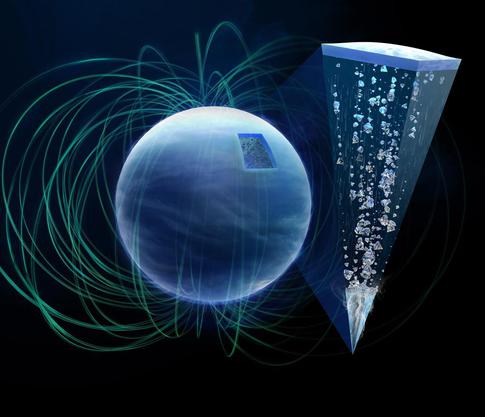XFEL: New findings on diamond rain on ice planets
New findings on diamond rain on ice planets

The graphic shows the diamond rain inside the planet, which consists of diamond sinking to through surrounding ice. Pressure and temperature continously increase on the way deeper inside the planet. Even in extremely hot regions, the ice remains due to the extremly high pressure. Copyright: European XFEL / Tobias Wüstefeld
In earlier work on X-ray lasers, scientists had already discovered that diamonds should form from carbon compounds in the interior of the large gas planets because of the high pressure prevailing there. These would then sink further into the interior of the planets as a rain of precious stones from the higher layers.

HED Experiment station at European XFEL. Copyright: European XFEL / Jan Hosan
On their way from the outer to the inner layers of the planets, the diamond rain can entrain gas and ice, causing currents of conductive ice. Currents of conductive fluids act as a kind of dynamo through which the magnetic fields of planets are formed. "The diamond rain probably has an influence on the formation of the complex magnetic fields of Uranus and Neptune," Frost said.
The group used a plastic film made from the hydrocarbon compound polystyrene as a carbon source. Under very high pressure, diamonds are formed from the foil - a process that takes place in the same way as in the interior of planets and which can be imitated at the European XFEL. The researchers generated the high pressure and the temperature of more than 2200 degrees Celsius that prevail inside the icy gas giants with the help of diamond stamp cells and lasers. The stamp cells function like a mini vice in which the sample is squeezed between two diamonds. With the help of the European XFEL X-ray pulses, the time, conditions and sequence of the formation of the diamonds in the stamp cell can be precisely observed.
The international research team also includes scientists from European XFEL, the German research centres DESY in Hamburg and the Helmholtz Centre Dresden-Rossendorf, as well as other research institutions and universities from different countries. The European XFEL user consortium HIBEF, involving the research centres HZDR and DESY, contributed significantly to this work.
"Through this international collaboration, we have made great progress at the European XFEL and gained remarkable new insights into icy planets," says Frost.
Publication:
M. Frost et al., Diamond Precipitation Dynamics from Hydrocarbons at Icy Planet Interior Conditions, “Nature Astronomy”, 2024, https://www.nature.com/articles/s41550-023-02147-x
DOI 10.1038/s41550-023-02147-x
Scientific contact:
Dr. Mungo Frost
SLAC National Accelerator Laboratory
Email: mdfrost@slac.standford.edu
Media contact:
Dr. Bernd Ebeling
Email: bernd.ebeling@xfel.eu
Tel. +49 40 8998 9 6921
